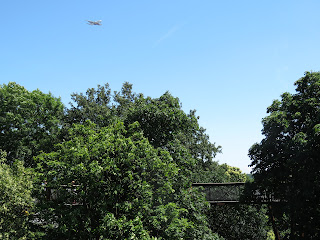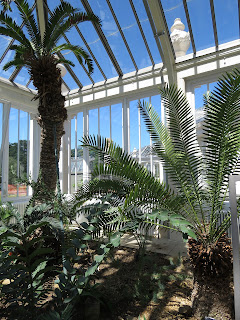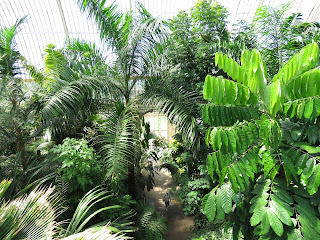 |
| The Palm House at Kew Gardens |
Day 2 in London saw us visiting Kew Gardens. This is my first visit to this, the largest and most diverse botanical collections in the world, which boasts of having over 30,000 of the world's plants. My dad, who as a gardener, has more interest in plants than I do. But whilst he is into plants for the aesthetic beauty, I'm more interested of coming here for the science. I'm no botanist or have a great knowledge of plant life, but I do find certain species or groups rather fascinating. And Kew has everything to please both those interested in plant beauty and science and has done so since Victorian times. So we are both in the right place.
[I apologise for not naming all the plants shown here, as I don't really remember them.]
 |
| The Great Broad Walk Borders |
 |
| The Hive |
 |
| Feral Pigeon sunbathing |
 |
| Treetop Walkway |

 |
| Sweet Chestnuts |
 |
| The Temperate House |
There was a lot of walking involved as we made our way from one giant greenhouse to another. Each one showcased some wonderful exotic plants. After 5 years of renovation, the Temperate House was now open to the public. It is without the biggest greenhouse in the world. The iconic Palm House, on the other hand, had more plants in it. It just seemed to be crammed with palms from around the world and you felt as if you were in the tropics with a sweltering heat greeting you, though the heat was more unbearable as you climbed the stairs to the platform above all these palms as your body suddenly drenches you in a bucket load of sweat.
 |
| Inside the Temperate House |
 |
| Inside the Palm House |

 |
| Bananas |
 |
| The Waterlily House |
 |
| The Rose Garden |
 |
| The Princess of Wales Conservatory |
However, the best of the collection in my opinion was inside the Princess of Wales Conservatory. A spectacular display of cacti ranging in various shapes and sizes greets you as you enter the entrance. Some of which only flower at night, where in the wild they would be pollinated by bats. Open through to the next room and a rainforest appears before you, complete with a tropical heat. Here, you can find the world's largest and smallest waterlilies floating right next to each other. There was a great collection of tropical orchids and air plants (plants that grow on the branches of rainforest trees) among many other stunning tropical plants. One of the most extraordinary in the collection was the titan arum, the world's largest flower (over 3m or 10ft), which blooms at night once every 2-10 years, producing a foul smell of rotting flesh to attract flies.
 |
| The Cacti display inside |
 |
| This particular species of cactus flowers at night |
 |
| Bee-wolf (which seemed to like soil the cacti were in to build it's nest) |
 |
| Me with the world's largest waterlily (Victoria amazonica) |
 |
| The world's smallest waterlily (Nymphaca thermarum) |
 |
| Titan Arum (the largest flower in the world) |

 |
| A display of air plants |
 |
| One of the many orchids on display |
 |
| Not sure |
 |
| Green Iguana |
 |
| Venus Flytrap |
If there's one group of plants that fascinate me more than any other, then it has to be the carnivorous plants. These sort of plants grow in poor nutrient soil, such as bogs. They have to find their vital nutrients elsewhere, from living things! To catch their prey, these plants have evolved a variety of different ways to trap them. Sundews have sticky leaves to snare insects, while Venus flytraps have their iconic beartrap-like leaves that snaps shut whenever a fly knocks into special hairs that act like trigger mechanisms. Out of all the carnivorous species, none are as diverse and as complex in design than the pitcher plants. They are basically a modified leaf that forms a funnel with a 'lid' that attracts prey with sweet nectar. This lure then leads the plant's victims to their deaths as they slip down into the funnel to a liquid at the bottom where they drown. The largest pitcher is the
Nyphenthes rajah, which is big enough to trap small mammals. Who said plants were boring?
 |
| Sundew |
 |
| Some of the many Pitcher Plant species on display |





































































No comments:
Post a Comment